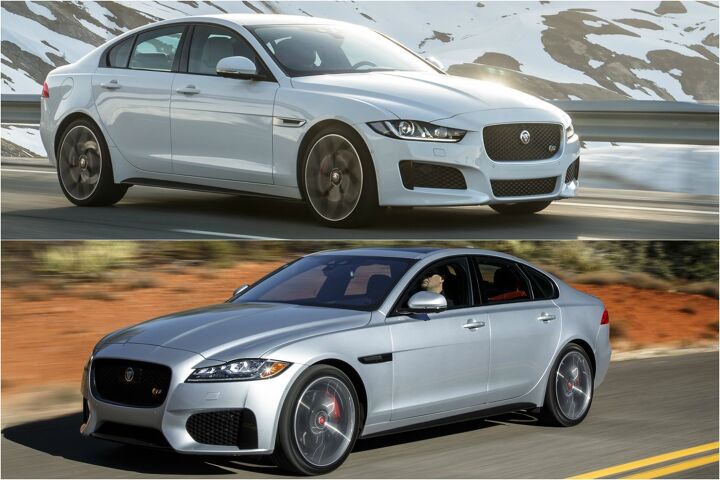One Look Shouldn't Fit All Sizes: Jaguar Design Boss Plans to Help Buyers Tell Models Apart
Fortunately, premium automakers have not adopted a One Size Fits All approach. We have choices. Plenty of choices.
Increasingly, however, we are seeing a One Look Fits All Sizes methodology, limiting our ability to distinguish between a 3 Series, 5 Series, and 7 Series at BMW; between A4s, A6s, and A8s at Audi; or between C, E, and S-Class sedans at Mercedes-Benz.
With the second-generation XF appearing all but identical to the first XF, and the subsequent launch of the entry-level XE closely resembling an abbreviated XF, Jaguar’s guilty of the same crime against differentiation.
Fortunately, famed Jaguar design director Ian Callum says future Jaguar designs won’t be revealed merely as S, M, and L versions of the same t-shirt.
“We will separate them more in the future,” Callum told Autocar, referencing the XE and XF in particular and confirming that the next-generation XE will also be rear-wheel-drive-based. While connected by traditional Jaguar themes, Jaguar will provide greater distinctions between its growing lineup. “There will be a constant grille, then a more flexible front.”
This explains why the new E-Pace, revealed yesterday, doesn’t look exactly like the larger F-Pace crossover. “We wanted the E-Pace to have its own character, its own place,” Callum told AutoExpress. “So its headlights are from the F-Type.”
Callum also says the E-Pace’s key side signatures, a line that begins at the headlights and disappears at the rear door along with a higher line that accentuates the hind quarters, are inspired more by the F-Type sports car than the F-Pace utility vehicle.
Design unity is integral to image building, particularly for luxury brands. High-end automakers want their entry-level buyers to feel as though they bought into something premium, an upmarket lifestyle. But if the entry-level model doesn’t look anything like its more expensive siblings, then what is the image-conscious customer acquiring?
Unfortunately, design unity has gradually become design uniformity. Without a measuring tape, it’s not easy to tell which one is the Audi A4 and which one is the Audi A6. Is that a C-Class Cabriolet or an E-Class Cabriolet?
Now it becomes Ian Callum’s job to convince Jaguar’s other division heads that some differentiation is healthy, as the need for greater distinction may only increase. Asked by Autocar about the potential for even smaller Jaguars, “No plans, but I’d like to think so,” Callum said.
[Images: Jaguar]
Timothy Cain is a contributing analyst at The Truth About Cars and Autofocus.ca and the founder and former editor of GoodCarBadCar.net. Follow on Twitter @timcaincars.
More by Timothy Cain
Latest Car Reviews
Read moreLatest Product Reviews
Read moreRecent Comments
- ToolGuy Why would they change the grille?
- Oberkanone Nissan proved it can skillfully put new frosting on an old cake with Frontier and Z. Yet, Nissan dealers are so broken they are not good at selling the Frontier. Z production is so minimal I've yet to see one. Could Nissan boost sales? Sure. I've heard Nissan plans to regain share at the low end of the market. Kicks, Versa and lower priced trims of their mainstream SUV's. I just don't see dealerships being motivated to support this effort. Nissan is just about as exciting and compelling as a CVT.
- ToolGuy Anyone who knows, is this the (preliminary) work of the Ford Skunk Works?
- Kwik_Shift_Pro4X I will drive my Frontier into the ground, but for a daily, I'd go with a perfectly fine Versa SR or Mazda3.
- Zerofoo The green arguments for EVs here are interesting...lithium, cobalt and nickel mines are some of the most polluting things on this planet - even more so when they are operated in 3rd world countries.



































Comments
Join the conversation
The only ones I can't tell apart are the Audis, and that's only because the A6 and A8 sell in such minuscule numbers. The Mercedes can easily be figured by amount of ugliness, they generally get better looking the bigger they are.
Say what you want about the Buick ventiports, but when they were properly implemented it told you exactly what model it was.